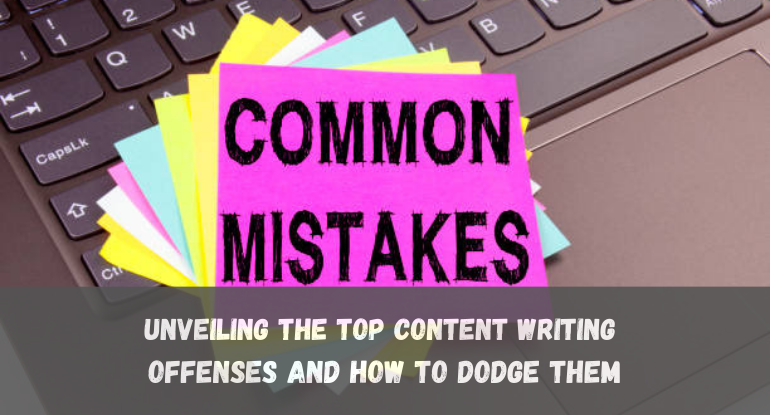
Unveiling the Top Content Writing Offenses and How to Dodge Them
Whether you're a blogger, a business owner, or a marketer, crafting compelling content is essential for engaging your audience and driving success.
However, even the most seasoned content writers can fall prey to common writing offenses that can undermine the effectiveness of their work.
In this comprehensive guide, we'll unveil the top content writing offenses and provide actionable strategies to dodge them, helping you elevate your content game to new heights.
What is Content Writing?

Content writing involves creating written material for various purposes, platforms, and audiences. It encompasses crafting articles, blog posts, website content, social media updates, marketing materials, and more.
The goal of content writing is to communicate ideas, information, or stories effectively to engage and inform the intended audience. It often involves researching, organizing, and presenting information in a compelling and engaging manner while adhering to the specific goals and tone set by the content's purpose and the brand or individual it represents.
Good content writing aims to captivate readers, deliver value, and evoke a desired response or action.
Top Content Writing Offenses and How to Dodge Them
#1. Ignoring the Audience:
Ignoring your audience can be a critical misstep in content writing. It's akin to preparing a meal without considering the tastes and dietary preferences of your guests—it's unlikely to satisfy or leave a lasting impression. To sidestep this pitfall, embark on a journey of comprehensive research aimed at understanding your audience inside out.
Start by crafting detailed buyer personas, essentially creating fictional characters that represent segments of your audience. Dive into demographics such as age, gender, location, occupation, and income level.
But don't stop there, delve deeper into their psychographics, understanding their interests, hobbies, values, and aspirations. What keeps them up at night? What problems are they desperate to solve? Understanding their pain points is crucial.
Equally important is grasping their preferred communication styles. Some audiences might resonate with a conversational, friendly tone, while others might prefer a more formal and informative approach. By honing in on these nuances, you can tailor your content to speak directly to your audience, using language and tone that resonates with them.
The beauty of this approach lies in its ability to humanize your audience. They're not just numbers or statistics but real individuals with unique preferences and needs. When you create content that genuinely addresses these needs and preferences, you'll forge a deeper connection. Your audience will feel seen, heard, and understood, leading to heightened engagement and relevance.
#2. Poor Structure and Organization:
Content that lacks a clear structure or is disorganized can confuse readers and drive them away. To dodge this offense, create an outline before writing.
Start with a compelling introduction, followed by well-structured main points, and conclude with a strong call-to-action or summary. Use subheadings, bullet points, and concise paragraphs to enhance readability and flow.
Keyword Stuffing and Over-Optimization:
While incorporating keywords is crucial for SEO, overusing them can harm the readability and authenticity of your content.
Dodge this offense by focusing on natural incorporation of keywords. Use them strategically and organically throughout your content, ensuring a smooth reading experience while still optimizing for search engines.
#3. Plagiarism and Lack of Originality:
Plagiarism and the absence of originality represent more than just ethical concerns; they undermine the very essence of authentic creation. When content lacks originality, it diminishes the trust and credibility established with your audience.
The digital landscape thrives on unique perspectives and fresh ideas. Therefore, it's imperative to steer clear of copying material from other sources.
Instead, invest in crafting content that embodies your unique voice and insights. Utilize tools like plagiarism checkers to ensure the authenticity of your work. Strive to infuse your creations with fresh perspectives, personal anecdotes, or comprehensive research.
By doing so, you not only set yourself apart from the myriad of information available but also contribute valuable, distinct content that resonates with your audience.
#4. Weak Headlines and Introductions:
Your headline and introduction are the first impressions of your content. Weak, uninspiring ones can fail to capture the audience's attention.
To dodge this offense, craft attention-grabbing headlines and compelling introductions that entice readers to continue exploring your content.
#5. Neglecting Editing and Proofreading:
Neglecting the crucial steps of editing and proofreading can significantly diminish the quality of your content. Grammatical errors, typos, and inconsistencies can detract from the overall message you aim to convey.
To ensure high-quality output, it's imperative to dedicate time and effort to meticulous editing and proofreading before publishing your work. Utilize grammar and spell-check tools to catch basic errors, take breaks between writing and editing sessions to maintain a fresh perspective, and consider seeking feedback from peers or professional editors.
These steps collectively contribute to refining your content, making it more polished and impactful for your audience.
#6. Lack of Visual Appeal:
Content that relies solely on text lacks the dynamic appeal that visuals bring. Integrating relevant images, infographics, videos, or other visual elements alongside your text is key.
These visual aids serve to break the monotony, heighten comprehension, and significantly boost the overall appeal of your content.
They not only capture attention but also engage the audience more effectively by catering to various learning styles and enhancing the overall experience of consuming the information you're sharing.
#7. Failure to Provide Value:
Your content should always strive to provide meaningful value to your audience. Whether its purpose is to educate, entertain, or solve problems, it's crucial to ensure that your content serves its intended purpose effectively.
Aim for your content to leave the reader with valuable takeaways or actionable insights that they can apply or reflect upon.
This value-addition ensures that your audience not only consumes your content but also gains something substantial from it, making their engagement more impactful and rewarding.
Content creation tips

#1. Understanding Your Audience: Understanding your audience is akin to knowing the people you're inviting to your party. It's not just about numbers; it's about comprehending their desires, struggles, and interests.
Picture creating content as throwing a gathering you tailor everything from the invitations to the entertainment to suit your guests. Similarly, in content creation, knowing your audience's preferences and pain points becomes the cornerstone of your strategy.
What are their burning questions? What problems keep them up at night? Understanding these facets enables you to craft content that resonates deeply with them, forging a stronger connection.
#2. Creating Valuable Content: Think of your content as a gift to your audience. Just like any present, it should be something worth receiving—useful, entertaining, or enlightening. Imagine you're offering a solution to a problem they're facing or providing them with information that makes their lives easier.
Valuable content not only captures attention but also prompts sharing and engagement. It's the difference between handing someone a generic trinket or presenting them with a thoughtful, purposeful gift—they'll cherish the latter and likely want to share it with others.
#3. Consistency is Key: Consistency is akin to reliability in a friendship. It's about showing up when you say you will. Regularly publishing content is like meeting a friend for coffee every week you maintain that connection and build anticipation for what's next.
Your audience grows accustomed to your rhythm, eagerly waiting for your next piece of content. This consistent presence strengthens the bond between you and your audience, fostering loyalty and trust.
#4. Quality Over Quantity: Quality triumphs over quantity. It's like serving a delicious, well-crafted meal instead of a buffet of mediocre dishes. Your audience craves content that's meticulously curated, informative, or entertaining.
One exceptional piece of content holds more value and impact than several rushed, mediocre ones. It's about leaving a lasting impression rather than flooding your audience's feed with forgettable material.
#5. Use Engaging Formats: Experimenting with different content formats is like offering a diverse menu at a restaurant that caters to various tastes. Some prefer videos, others adore infographics, and some might be fans of podcasts.
By diversifying your content formats, you accommodate different preferences, ensuring your content reaches and engages a broader audience.
#6. SEO Optimization:
SEO is like adding signposts to guide people to your content. Understanding basic SEO principles helps make your content more discoverable amidst the vast digital landscape.
It involves using relevant keywords naturally without overloading your content. Think of it as ensuring your content appears on the map when your audience goes searching.
#7. Visual Appeal: Visuals are the décor that enhances your content—it's like dressing up a well-prepared dish to make it irresistible. High-quality images, videos, and graphics complement your written content, making it more visually appealing and engaging for your audience.
#8. Tell Compelling Stories:
Stories are the emotional glue that binds your audience to your content. Crafting narratives that resonate with your audience creates a deeper connection and makes your message more impactful.
Think of it as painting a vivid picture that captivates their imagination and emotions.
#9. Encourage Interaction: Encouraging interaction with your audience is akin to hosting a lively conversation at your party.
Invite comments, shares, and discussions. Engage with your audience to create a sense of community. It's about fostering a space where everyone feels heard and valued.
#10. Stay Updated: Staying updated on trends and developments is like keeping your finger on the pulse of the conversation.
Just as you'd stay updated on current events to engage in discussions at a gathering, staying abreast of industry trends and interests helps keep your content relevant and fresh.
#11. Analytics and Feedback:
Tracking metrics and analyzing feedback is akin to seeking opinions on your party—it helps you understand what worked well and what didn't. By examining the data and feedback, you gain insights into what resonates with your audience, allowing you to refine and improve your content strategy.
#12. Be Authentic: Authenticity is the genuine, welcoming demeanor you exude at your party—it builds trust and rapport with your guests. Similarly, being authentic in your content establishes a stronger connection with your audience.
It's about being true to yourself and your brand, fostering a relationship based on trust and reliability.
Conclusion
By avoiding these content writing offenses and implementing the suggested strategies, you can elevate the quality and impact of your content. Remember, continuous improvement and adaptation to your audience's changing needs are key to creating content that resonates and drives success in today's competitive landscape.
Mastering the art of content writing takes practice, but with dedication and attention to detail, you'll create compelling content that captivates your audience and achieves your goals.